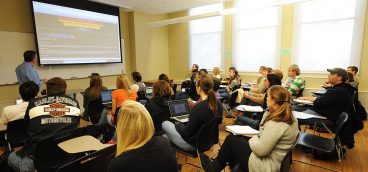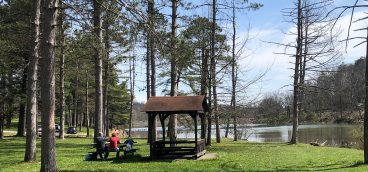
Hulking steam engines, nearly a century old, await repairs in their original roundhouse in Rockhill Furnace, Pa. The crisp country air fades into the smell of an industrial past next to No. 14, a “snappy engine,” according to Linn Moedinger, a mechanical advisor at East Broad Top Railroad, who works on restoring the machines.
“It’s a magical place,” Moedinger said. “This is how a roundhouse should smell — a lot of steam oil, permeating everything, graphite and grease.”
Here in a little-known enclave in Pennsylvania, the past and perhaps the future of railroads reside. Old steam engines have been restored and a new battery-powered train tests its potential. In 2020, the East Broad Top Foundation, a nonprofit formed to preserve the historic site, bought the East Broad Top Railroad and restored Baldwin No.16 steam engine to operation. Puffs of gray smoke billow as it chugs along four-and-a-half miles of restored main line running tourists out into the countryside, the steam whistle blowing.
Across the tracks, a quieter, cleaner train prepares for the future. A demonstration run of the battery-powered Pop-Up Metro Train glides on a 1.8-mile stretch of track, reaching a speed of 45 miles per hour. It’s a model of an alternative commuter rail transit system using battery-powered trains and existing freight rail lines — one already in operation in parts of the United Kingdom. Pop-up Metro leases the trains, a modular platform, charging equipment and training to interested communities to test local markets and bypass some of the long, expensive political processes involved in designing a massive public transportation project.

“There is nothing like it in this country,” said Henry Posner, chairman of Pop-Up Metro and East Broad Top Foundation. “Both the past and future of rail are within walking distance.”
AWAKENING THE PAST
The archives at East Broad Top Railroad tell a deep history of a line that ran from 1873 to 1956, hauling coal and passengers from Mount Union to the mines of Broad Top Mountain.
A local scrap dealer named Nick Kovalchick bought the railroad and converted a section into a tourist railroad in 1960, putting engines to work and leaving the original workshops at rest. The tourist operations ended in 2011 and lay dormant until 2020, when the EBT Foundation purchased the railroad and began to restore the engines, workshops and rail line.
Old advertisements, photographs of children sticking their heads out of a train car, and blueprints of the engines mark periods in its history, but it’s the volumes of mechanical reports that provided the key to the railroad’s restoration. They hold detailed daily inspection reports, telling which engine broke down, what day and why. When the EBT Foundation awakened the railroad, they selected the Baldwin No.16 from 1916 as the first for a repair.
“When you work with them long enough, they all have personalities,” Moedinger said. No. 16 had a reputation for being a “walker,” meaning the engine would drift forward when parked in its stall. Patched brickwork on the roundhouse confirms the story told by the written records.
Visitors can take a ride on No. 16 and the site hosts events throughout the summer and fall, including a living history event in May featuring about 150 historic reenactors, according to Brad Esposito, general manager of East Broad Top Railroad. The goal, over time, is to open up nine more miles of rail line, fix up the other Baldwin engines-in-waiting and return them to service. Esposito wants to host more demonstrations at the railroad and in the workshops, creating an experience “sort of like Colonial Williamsburg.”

The preserved workshop run by belt-driven machinery is a rare time capsule. The original casting patterns for coal cars hang on the wall and leather belts snake overhead, connecting machines. Friends of the East Broad Top, a nonprofit support group for the site, is working to bring the site’s 1920s-era workshop back to life.
“The workshops are more interesting than the railroad, in my opinion, because you have the complete steam-era, belt-driven machinery, hammers and grinding machines that it would take to actually build freight cars,” Posner said. “It’s a self-contained, industrial history village.”
LINING THE FUTURE
Across a baseball field from the workshop, within earshot of whistle blasts, a shiny bright orange, battery-powered modular train imported from Britain shows off its potential on existing rail. Posner, also a founder of Railroad Development Corporation, which owns railroads in locations from Iowa to Peru, developed Pop-Up Metro as a turnkey transit business that can operate on existing rail lines. Two cars with battery technology from Vivarail, along with a platform and other operating support, can be leased. “You’ll be able to run this system for a year and find out if there is a market potential, faster than if you had engaged a consultant and for the same cost,” Posner said.

The batteries can power the train for four to six hours and reach a peak speed of 60 miles per hour at full charge, although the Rockhill Furnace demonstration topped out around 40 miles per hour. The system is in operation in parts of the UK, including a main line service on the Isle of Wight.
“We feel our competitive advantage is that we make the pie bigger for rail-based transit and allow things to get done within the political cycle of decision-makers,” Posner said. “It makes transit projects less risky and we can deliver them faster.”
Promise lies in commuter corridors in disuse, underutilized railroads and fragmented public transportation systems in need of short commuter connection. Pop-Up Metro targets public systems in need of upgrades or adding a rail-based option, as well as private developers who might want to add a rail service to their project. Potential transit opportunities exist across the country, although most are clustered in New England and California, where governments are “more focused on sustainability and have more money,” according to Posner.

The most plausible application for Pop-Up Metro is to restore service from Westchester, Pa., on the outer end of a Philadelphia commuter line to Wawa, Pa. It would include a stop at Cheyney University, the country’s oldest Historically Black College and University, which never had its own stop.
They have a patent pending on their leasing business model. Its flexibility and application “are not subject to changing political times,” Posner said.
Extending the line and the future applications of Pop-Up Metro in the U.S. relies on getting local governments, organizations, rail owners and operators on board. “The single most important challenge is making sure we have a local partner, and having some acceptance that this is something that needs to be done,” Posner said. “If there is no community consensus and we don’t find a local partner, then it probably won’t be successful.”












